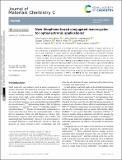Files in this item
New thiophene-based conjugated macrocycles for optoelectronic applications
Item metadata
| dc.contributor.author | dos Santos, John Marques | |
| dc.contributor.author | Jagadamma, Lethy Krishnan | |
| dc.contributor.author | Cameron, Joseph | |
| dc.contributor.author | Wiles, Alan A. | |
| dc.contributor.author | Wilson, Claire | |
| dc.contributor.author | Skabara, Peter J. | |
| dc.contributor.author | Samuel, Ifor D. W. | |
| dc.contributor.author | Cooke, Graeme | |
| dc.date.accessioned | 2021-07-29T14:30:10Z | |
| dc.date.available | 2021-07-29T14:30:10Z | |
| dc.date.issued | 2021-07-15 | |
| dc.identifier | 275227382 | |
| dc.identifier | 634480db-92dd-462b-bad3-df9904575806 | |
| dc.identifier | 000673566500001 | |
| dc.identifier | 85120381930 | |
| dc.identifier.citation | dos Santos , J M , Jagadamma , L K , Cameron , J , Wiles , A A , Wilson , C , Skabara , P J , Samuel , I D W & Cooke , G 2021 , ' New thiophene-based conjugated macrocycles for optoelectronic applications ' , Journal of Materials Chemistry C , vol. Advance Article . https://doi.org/10.1039/D1TC02002A | en |
| dc.identifier.issn | 2050-7526 | |
| dc.identifier.other | RIS: urn:E2B3EABC9417DD848907AFF3786D3550 | |
| dc.identifier.other | ORCID: /0000-0002-4339-2484/work/97885502 | |
| dc.identifier.uri | https://hdl.handle.net/10023/23680 | |
| dc.description | GC acknowledges the EPSRC for funding (EP/E036244/1). JMS acknowledges the Coordenação de Aperfeiçoamento de Pessoal de Nível Superior – Brasil (CAPES) – Finance Code 001 for PhD funding. JMS also acknowledges Dr Nor Basid Adiwibawa Prasetya for helpful advice. Dr L. K. Jagadamma acknowledges support from a Marie Skłodowska-Curie Individual Fellowship (European Commission) (MCIF: No. 745776). | en |
| dc.description.abstract | Thiophene-based semiconductors are amongst the most successful materials in organic electronics. In this contribution, we present the synthesis and characterisation of two thiophene-based macrocycles as well as their evaluation in organic-electronic devices. McT-1 is composed of ten thiophene moieties, whereas in McT-2, four additional electron-deficient benzothiadiazole moieties are incorporated to form a donor–acceptor (D–A) π-system. Red-shifted and broadened absorption spectra as well as more positive redox potentials are observed in McT-2, whereas McT-1 displays a sharper absorption band with a higher extinction coefficient. Macrocycle McT-1 shows emission in the yellow region whereas McT-2 displays emission in the red wavelength region. DFT calculations predict the macrocycles to comprise of mainly the E,E isomers with a near-planar structure, which is further supported by the single crystal X-ray structure for McT-1. Their charge transporting properties are determined by fabricating thin-film OFETs. The photovoltaic properties of McT-1 and McT-2 are also investigated by fabricating bulk heterojunction (BHJ) devices and their potential as photodetectors has been evaluated. | |
| dc.format.extent | 15 | |
| dc.format.extent | 5949612 | |
| dc.language.iso | eng | |
| dc.relation.ispartof | Journal of Materials Chemistry C | en |
| dc.subject | QD Chemistry | en |
| dc.subject | DAS | en |
| dc.subject | SDG 7 - Affordable and Clean Energy | en |
| dc.subject.lcc | QD | en |
| dc.title | New thiophene-based conjugated macrocycles for optoelectronic applications | en |
| dc.type | Journal article | en |
| dc.contributor.sponsor | European Commission | en |
| dc.contributor.institution | University of St Andrews. School of Chemistry | en |
| dc.contributor.institution | University of St Andrews. School of Physics and Astronomy | en |
| dc.contributor.institution | University of St Andrews. Centre for Energy Ethics | en |
| dc.contributor.institution | University of St Andrews. Centre for Biophotonics | en |
| dc.contributor.institution | University of St Andrews. Condensed Matter Physics | en |
| dc.identifier.doi | 10.1039/D1TC02002A | |
| dc.description.status | Peer reviewed | en |
| dc.identifier.grantnumber | 745776 | en |
This item appears in the following Collection(s)
Items in the St Andrews Research Repository are protected by copyright, with all rights reserved, unless otherwise indicated.

